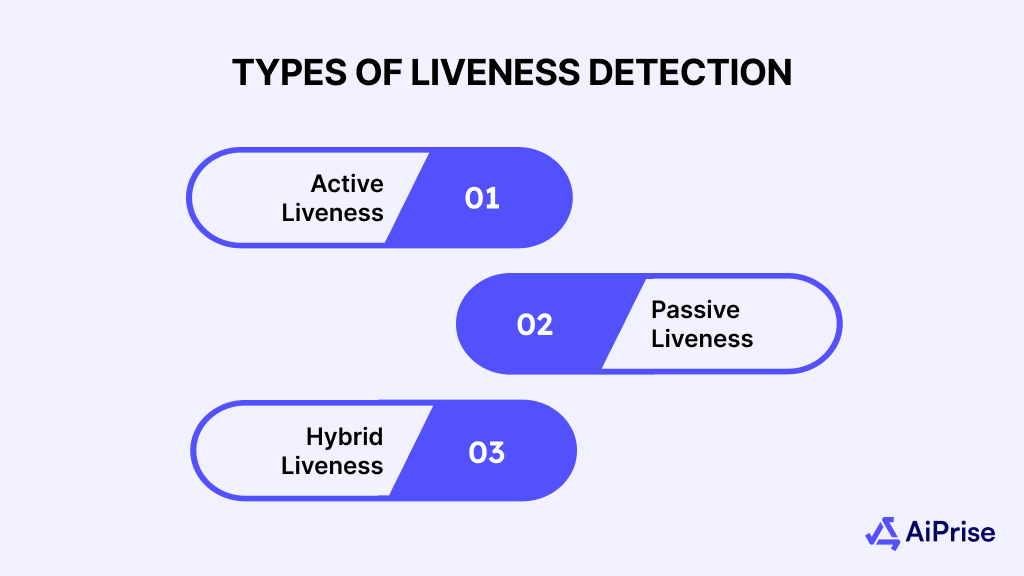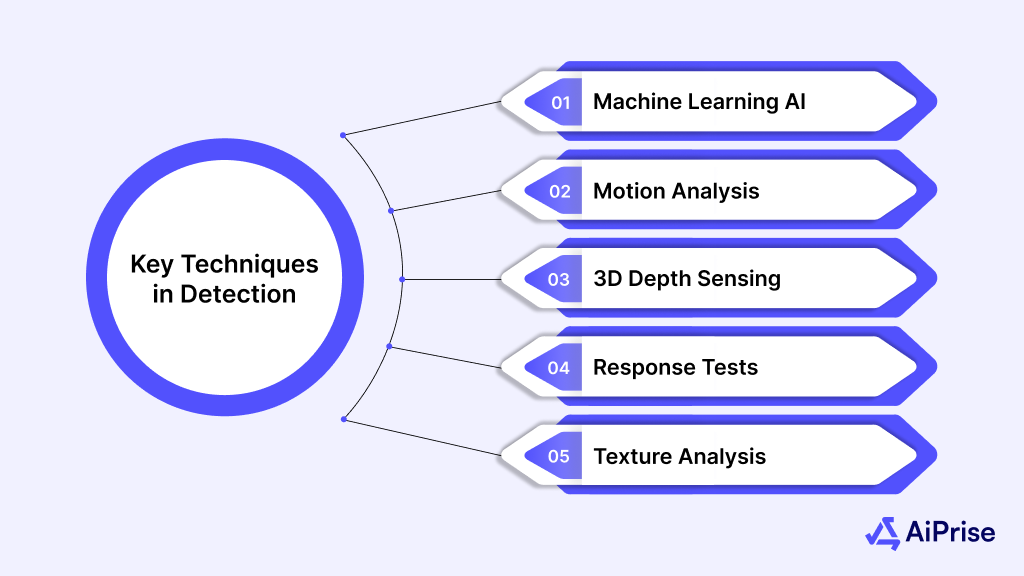AiPrise
11 mins read
August 22, 2025
Liveness Detection: Your Guide to Modern Fraud Prevention

Key Takeaways










Fraudsters are getting smarter, and their tools are getting more convincing. According to a report by Entrust, a deepfake attack occurred, on average, every five minutes in 2024, with digital document forgeries surging by 244% year-over-year. This isn't just a distant problem; it's a direct threat to your business, your customers, and your bottom line.
As AI makes it easier to create hyper-realistic fakes, the old ways of verifying identity are no longer enough to keep your business safe. To secure your platform, you need a crucial line of defense that goes beyond traditional checks.
In this blog, we'll explore what liveness detection is and how it can help your business fight back against the newest generation of fraud.
Key Takeaways
- AI-driven fraud, like deepfakes, makes traditional identity checks obsolete. Your business needs liveness detection to verify that a real person is present in real time.
- Understand the difference between passive, active, and hybrid liveness detection to choose a solution that balances your security needs with a frictionless user experience.
- Liveness detection is more than a security tool; it's a strategic asset that builds customer trust, improves onboarding, and directly reduces fraud-related financial losses.
- Instead of managing multiple vendors, find a comprehensive platform that unifies liveness detection with all your KYC, AML, and fraud prevention tools.
What Is Liveness Detection?
Liveness detection is a technology that verifies if a biometric sample, typically a facial scan, originates from a real, present human being. Its purpose is to distinguish between a live user and a fraudulent attempt using a photo, a pre-recorded video, or a deepfake.
The technology works by analyzing subtle cues that are unique to a living person, such as natural micro-movements, reflections, and three-dimensional characteristics. This process confirms that the individual is physically present during the verification, effectively preventing sophisticated spoofing attacks.
For a financial institution, this means that when a customer undergoes a digital identity check, the system can confirm they are not holding up a photo or a video of someone else. The technology provides a critical layer of security, ensuring that the person creating a new account is the same person whose identity is being verified.
However, liveness detection isn't a one-size-fits-all solution. Its evolution has led to distinct methods designed to meet varying business needs.
Types of Liveness Detection

To select the best solution for your business, you need to understand the different approaches. The key is to find a method that not only provides robust security but also delivers a seamless user experience. This balance is crucial for retaining customers during the verification process.
Active Liveness Detection
Active liveness detection requires the user to perform a specific action to prove they are a live human. This method explicitly prompts the user to interact with the camera, making the verification process overt and clear.
For example, a user might be asked to do the following:
- Blink or turn their head
- Smile or say a short phrase
- Read a series of numbers out loud
This approach offers a high degree of security because it’s difficult for a fraudster to replicate these random, specific actions with a static photo or video. However, it can introduce friction, slowing down the user onboarding process and potentially leading to a less-than-seamless experience.
Passive Liveness Detection
Passive liveness detection is a frictionless approach that works silently in the background without any user interaction. The user simply needs to look at the camera for a moment, and the technology does the rest.
This method uses advanced AI to analyze subtle, involuntary cues from a single video frame or a short video stream. It examines the following factors:
- The natural micro-movements of a human face
- Light reflections and shadows on the skin
- Texture and depth to determine if the user is a real person or a flat image
As it requires no action from the user, passive liveness detection offers a superior experience, making the identity verification process feel instant and effortless.
Hybrid Liveness Detection
Hybrid liveness detection combines the best features of both active and passive methods. This approach prioritizes a smooth user experience but retains the option for an additional security check when needed.
The process typically begins with a passive check. If the system's confidence score is high, the verification is completed instantly. However, if the system detects a low confidence score or a potential risk, it can automatically trigger a secondary, active check. This intelligent workflow ensures that the majority of users have a frictionless experience while high-risk situations are subject to additional scrutiny.
With a clear understanding of the different types, let's explore the underlying technology that makes liveness detection possible.
How Liveness Detection Works?
Liveness detection works by using advanced technology to analyze a user's behavior and physical characteristics in real time. The goal is to collect and verify data that is impossible for a fraudster to replicate with a static photo, a video, or an AI-generated deepfake.
The process typically begins with the user's camera, which captures a brief video or a series of images. This data is then sent to the system's analysis engine, which employs several techniques to verify liveness.
Key Techniques Involved in Liveness Detection

The technology relies on a combination of advanced computer vision and machine learning models to perform these checks. The primary techniques can be grouped by how they verify authenticity:
- Machine Learning AI: This is the foundation of any modern liveness detection system. An AI model is trained on a vast dataset of both real and fraudulent verification attempts. This allows the system to analyze incoming data in real time, learn new fraud patterns, and make highly accurate decisions on whether an attempt is genuine or a spoof.
- Motion Analysis: This technique is a core component of both active and passive detection. It analyzes the fluidity and naturalness of a user's movements, such as a head turn, blink, or a slight shift in posture. A static photo or a pre-recorded video will lack these subtle, natural movements, making them easy to identify as fraudulent.
- 3D Depth Sensing: This method uses sensors or advanced algorithms to create a depth map of the user's face. It verifies that the subject is a three-dimensional object and not a flat image. This protects against traditional fraud methods like holding up a printed photo or a photo on a phone screen.
- Challenge and Response Tests: This is a key part of an active liveness detection solution. The system prompts the user to perform a random action, such as blinking, smiling, or speaking a unique phrase. The system then analyzes the video to ensure the action was performed naturally and in real-time, making it extremely difficult for a fraudster to fake.
- Texture Analysis: This technique inspects the microscopic details of the user's skin. It looks for characteristics like skin tone, pores, and reflections, which are lost in a deepfake or a digital image. This provides an additional layer of security to ensure the subject is a genuine human and not a highly-edited photo or AI-generated image.
These advanced techniques form an invisible shield, providing a level of security that traditional checks cannot match.
But beyond the technical details, liveness detection translates directly into several advantages for your business.
Why Liveness Detection Is Important for Your Business?
Beyond just a technical tool, liveness detection is a strategic tool that directly impacts your business's security, profitability, and reputation. It's the difference between simply checking a box for compliance and proactively building a secure, trustworthy environment for your customers.
Here's how this technology delivers immense value to your organization:
- Combats Advanced Fraud and Synthetic Identities: Liveness detection directly addresses modern fraud by confirming a user's real-time presence. It stops criminals from using hyper-realistic deepfakes or stolen data to create "synthetic identities," which, according to Experian, made up nearly one-third of all identity fraud cases in 2024. This crucial biometric layer prevents attacks at the source.
- Reduces Fraud-Related Financial Losses: The direct outcome of enhanced security is a significant reduction in fraudulent incidents. This financial threat is growing; consumer-reported losses to fraud reached over $12.5 billion in 2024, a 25% increase over the previous year. By preventing fraudsters from impersonating a legitimate user, liveness detection protects your business from the costly consequences of this trend, including chargebacks, reputational damage, and the operational expenses of managing fraud.
- Adds a Reliable Layer of Security: Liveness detection goes beyond traditional, knowledge-based measures that are vulnerable to data breaches. It shifts your security from "what a user knows" to "who a user is." This biometric verification creates a non-replicable and highly secure layer that is far more reliable for applications and transactions than outdated questions.
- Ensures Customer Data Privacy: A robust liveness detection system is built to protect customer data. It converts biometric data into an encrypted, non-reversible template, ensuring sensitive information is used only for immediate verification and cannot be stolen or misused. This demonstrates your commitment to privacy and builds trust with your user base.
- Enhances Customer Experience: By enabling a fast, frictionless onboarding process, liveness detection helps you quickly and confidently onboard new customers. This seamless start is crucial, as a poor onboarding experience is a major cause of customer churn, with some reports citing that over 50% of churn can be attributed to it.
These strategic benefits become even clearer when we look at how liveness detection is being successfully applied across various industries.
How Businesses Use Liveness Detection?

Liveness detection is a foundational layer of security for any organization that handles sensitive data or high-value transactions. Here are a few examples of how businesses across different sectors use this technology to protect their operations and customers.
Financial Services and Banking
In finance, liveness detection is a critical tool for digital onboarding. Banks and fintech platforms use it to verify a new customer's identity during the account opening process. By pairing a liveness check with a document scan, they ensure the person applying for a loan or a new account is a real, live individual, effectively preventing synthetic identity fraud and account takeover attempts.
E-Commerce and Online Marketplaces
E-commerce businesses and online marketplaces use liveness detection to prevent fraudulent transactions and build trust. By verifying a customer's identity during high-value purchases or account creation, they can prevent account takeover fraud and reduce the risk of fraudulent chargebacks. This also helps platforms ensure sellers are legitimate, protecting buyers and the marketplace's reputation.
Cryptocurrency Platforms and Gaming
For industries with anonymous and high-value transactions, liveness detection is essential for compliance and fraud prevention. Crypto exchanges use it as part of their Know Your Customer (KYC) process to verify a user's identity before they can trade. Similarly, online gaming platforms use it for age verification and to prevent cheating or the use of multiple accounts to manipulate in-game economies.
As liveness detection is now a crucial component across so many industries, you must choose an ideal partner to help you implement it strategically.
Why Choose AiPrise for Liveness Detection?
AiPrise is a platform built for modern identity verification, bringing together all the tools you need into a single, intuitive solution. By integrating advanced liveness detection into a broader suite of services, AiPrise helps businesses quickly and confidently verify users in over 200 countries.
Here's what AiPrise offers to help you implement a robust liveness detection strategy:
- 1:N Face Match: AiPrise's platform uses a "1:N Face Match" feature to eliminate fraudulent onboarding attempts. It compares a new user's face against an existing database of faces to detect and block duplicates.
- Deepfake & Spoof Prevention: The platform uses cutting-edge analysis techniques to combat deepfakes and prevent spoofing. Its AI-powered algorithms protect against sophisticated fraudulent attempts like static photos, video replays, and deepfake attacks.
- Instant Proof of Life Checks: The system provides instant proof of life checks to ensure the user is real and physically present. This protects against spoofing attempts and provides an extra layer of security during the verification process.
- Streamlined Onboarding: AiPrise enhances onboarding efficiency by bringing together document verification, face liveness, AML, address verification, and fraud detection into one unified workflow, helping you make confident, risk-based decisions faster.
By using an integrated platform like AiPrise, you can manage these critical checks from a single point, ensuring your fraud strategy is not only robust but also efficient and scalable.
Conclusion
Liveness detection is an essential component of any modern security strategy. As fraudsters employ increasingly sophisticated AI to create deepfakes and spoofing attacks, relying on outdated verification methods puts your business at significant risk. By implementing a solution that can accurately distinguish a real person from a fraudulent attempt, you build a stronger and more resilient defense.
Choosing the right liveness detection solution is about more than just technology; it's about building trust and ensuring a seamless experience. To protect your business and customers, consider a comprehensive platform that unifies liveness detection with all of your identity verification needs.
Ready to take the next step in fraud prevention? Book A Demo with AiPrise today to transform your digital onboarding and secure your business.
FAQs
1. How do you do a liveness check?
A liveness check is integrated into a digital verification flow. The user simply looks at their device's camera. The system then automatically analyzes the video for subtle cues, such as micro-movements and 3D depth, to confirm they are a real, present human.
2. What is the best face liveness detection?
The best tool depends on your business's needs for security and user experience. While passive liveness offers a seamless process, hybrid solutions provide a strong balance by using passive checks first and only requesting a user action for high-risk scenarios. This is the strategic approach offered by platforms like AiPrise, which combines top-tier liveness technology with a full suite of identity verification tools.
3. Why is liveness detection so important now?
Liveness detection is critical because traditional methods are no longer sufficient against new AI-driven fraud. With the rise of deepfakes and advanced spoofing, this technology provides a vital layer of security by confirming a user is a live person, not a fraudulent image or video.
4. What types of fraud does liveness detection prevent?
Liveness detection is designed to stop presentation attacks, which are attempts to fool a system with a fake biometric. It prevents fraud from static photos, pre-recorded videos, AI-generated deepfakes, and even physical masks, protecting against a wide range of spoofing attempts.
You might want to read these...

Aiprise has helped streamline our KYB (Know Your Business) flow in 100+ countries. No other tool comes close.





Speed Up Your Compliance by 10x
Automate your compliance processes with AiPrise and focus on growing your business.





